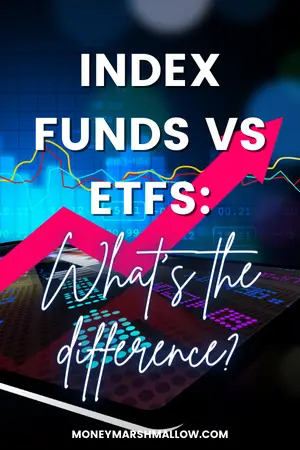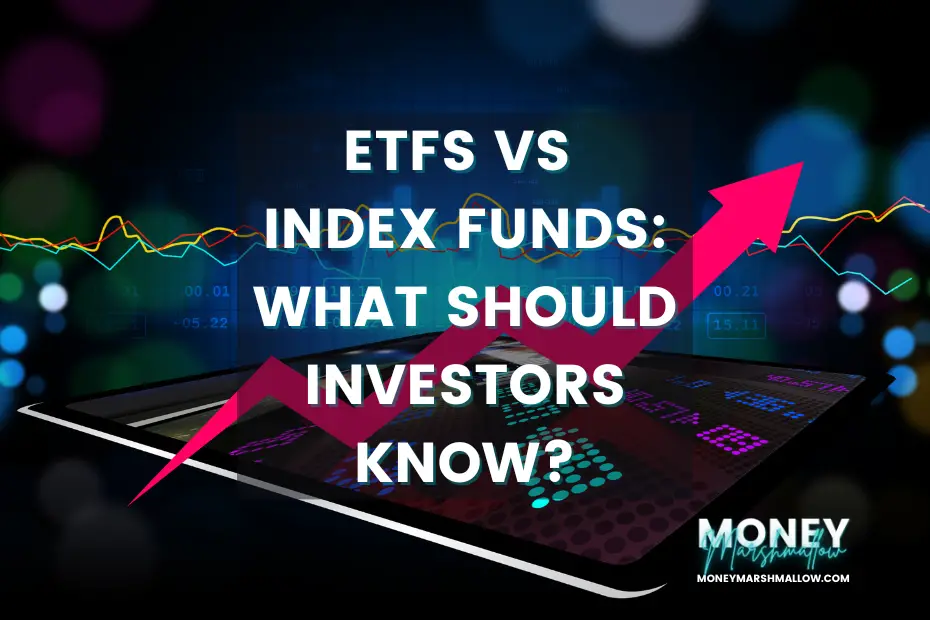Learning investing basics includes understanding the difference between ETFs and index funds. This guest post is written by Haydn, author of perpetualprudence.com, who will explain to us what investors need to know about the differences between the two.
Unfortunately kids there’s no little magic button under your desk that you can press to purchase whatever assets your (also little) brain or your mum or your financial adviser has told you to buy. You can’t just click your fingers and poof – you own a basket of financial products. Sadly it’s not that easy.
It’s not even easy to do this the way we usually buy financial things. Imagine purchasing all 100 companies listed in the FTSE 100. At a minimum, that’s a lot of button clicking and keyboard smashing. Now imagine maintaining this collection, weighted by market cap. That’s a full-blown hobby.
Where there is a need, a product or service is usually introduced to satisfy that need. So, the emergence of passive investing around 50 years ago created the demand for passive investment vehicles. It’s the two dominant species of these passive vehicles that we’ll be discussing today.
A two-horse race
When it comes to owning a collection of assets in a passive manner, there are two main vehicles you can use – index funds (IFs) and exchange-traded funds (ETFs).
How do these things allow you to “own” this collection?
In an ETF, the fund provider owns underlying assets in such a way as to track the performance of some index. You buy shares in this fund, not the actual assets. The fund owner then uses this capital to purchase more assets.
Index funds are set up almost identically. First, you add money to a pool. Then, the fund manager invests this money. Finally, they do this in such a way as to mirror the performance of some specified index.
As you might expect, these two vehicles are very similar. They are both:
- Passive
- Cheap
- Tax efficient
- Diverse
- Liquid
- Easy (to understand and purchase)

ETF vs. Index Funds: Practicalities
While ETFs and index funds have various similarities, there are some key differences too. Firstly, here are small, practical considerations.
Investing automatically typically isn’t possible with index funds. And even if it is – the amount you want to invest might not be large enough; index funds often have minimum amounts they accept for investment, whereas ETFs are purchased by the share. This is because ETFs are traded. This also means that when you go to buy an ETF, the price you see is the price you get.
Now let’s talk about the cost. Upfront costs: you have to pay the broker fee to execute the transaction, because ETFs are, again, traded. You don’t have to pay this explicitly when purchasing an index fund, but this is baked in to the fees somehow. This is because someone, somewhere in the chain will have to pay some sort of broker to make a market and execute some type of trade for them at some point. And another but: ETFs typically have lower ongoing costs, because the administrative fees and costs of running them are lower.
ETFs vs. Index Funds: Structure
Some index funds may also charge a fee for sales within, say 90 days of purchase. This isn’t a liquidity constraint as such, more like a liquidity incentive. This is the only real factor, liquidity-wise, given how liquid both of these vehicles are. Just think about pension funds, and their volume of buying or selling of any type of vehicle that tracks the S&P 500. It’s enormous.
But considering either a bizarro world in which liquidity dries up and/or the underlying structure of both vehicles, index funds are advantageous from a liquidity perspective. Because ETFs trade on markets, they are subject to market dynamics. Supply and demand mean that more sellers than buyers usually result in substantial drops in price. This is very unlikely (due to high liquidity and arbitrage opportunities), but it’s a possibility nonetheless. When investing in an index fund, there will always be a buyer – the fund will simply sell assets and return your money.
They can do this because they hold cash on reserve to cater to this very scenario. But this has a cost: they aren’t able to track the index as well as ETFs. This cash reserve means they can’t be fully invested.
To what extent these cash reserves inhibit the purchase of assets is a little difficult to determine at any one time because the providers of index funds don’t have to regularly disclose their holdings. This can usually be easily inferred, but if something questionable was going on, it would take a while before this would be exposed. This is in contrast to ETFs, which have to disclose what they own daily.
What does it all mean?
RECAP: ETFs and index funds are broadly the same with some less and some more significant differences.
However, turns out the differences are irrelevant enough to make practicality the determining factor. E.g. if you want to invest automatically and you can only do this using an ETF, use an ETF. If for some reason you only have index funds available to you, just buy the index fund.


Thanks once again to Roosa for letting me write this post for Money Marshmallow, it’s something I get quite a few questions about.
In the end, ETFs and Index Funds are broadly similar but in my personal opinion, ETFs have a slight edge!